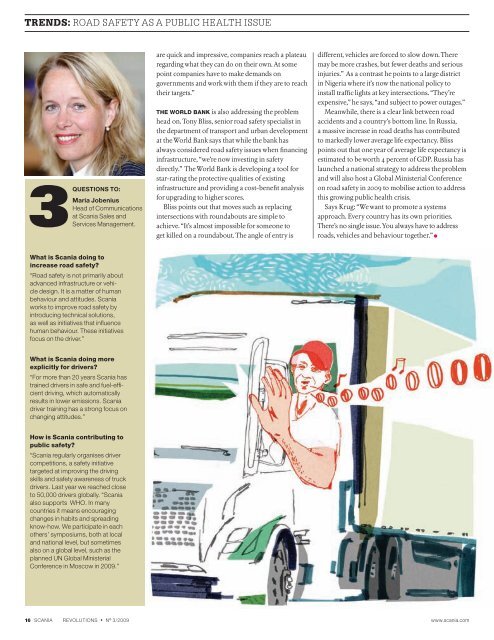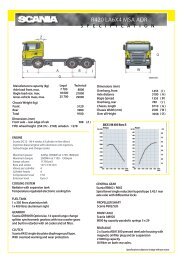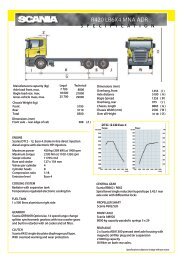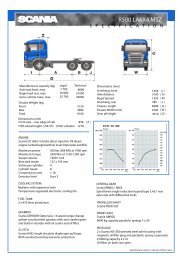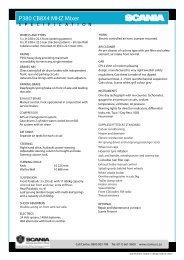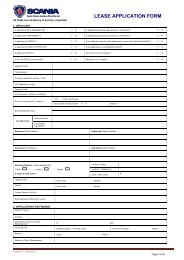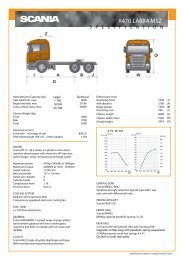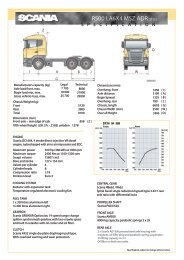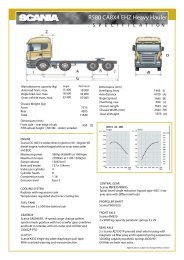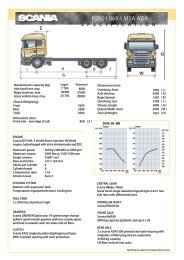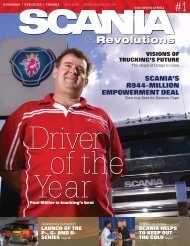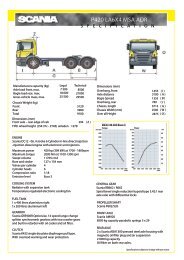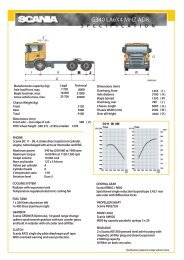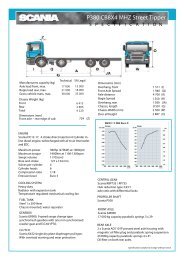Distributor - scania.co.bw
Distributor - scania.co.bw
Distributor - scania.co.bw
- No tags were found...
You also want an ePaper? Increase the reach of your titles
YUMPU automatically turns print PDFs into web optimized ePapers that Google loves.
TRENDS: ROAD SAFETY AS A PUBLIC HEALTH ISSUE3questions to:Maria JobeniusHead of Communicationsat Scania Sales andServices Management.are quick and impressive, <strong>co</strong>mpanies reach a plateauregarding what they can do on their own. At somepoint <strong>co</strong>mpanies have to make demands ongovernments and work with them if they are to reachtheir targets.”The World Bank is also addressing the problemhead on. Tony Bliss, senior road safety specialist inthe department of transport and urban developmentat the World Bank says that while the bank hasalways <strong>co</strong>nsidered road safety issues when financinginfrastructure, “we’re now investing in safetydirectly.” The World Bank is developing a tool forstar-rating the protective qualities of existinginfrastructure and providing a <strong>co</strong>st-benefit analysisfor upgrading to higher s<strong>co</strong>res.Bliss points out that moves such as replacingintersections with roundabouts are simple toachieve. “It’s almost impossible for someone toget killed on a roundabout. The angle of entry isdifferent, vehicles are forced to slow down. Theremay be more crashes, but fewer deaths and seriousinjuries.” As a <strong>co</strong>ntrast he points to a large districtin Nigeria where it’s now the national policy toinstall traffic lights at key intersections. “They’reexpensive,” he says, “and subject to power outages.”Meanwhile, there is a clear link between roadaccidents and a <strong>co</strong>untry’s bottom line. In Russia,a massive increase in road deaths has <strong>co</strong>ntributedto markedly lower average life expectancy. Blisspoints out that one year of average life expectancy isestimated to be worth 4 percent of GDP. Russia haslaunched a national strategy to address the problemand will also host a Global Ministerial Conferenceon road safety in 2009 to mobilise action to addressthis growing public health crisis.Says Krug: “We want to promote a systemsapproach. Every <strong>co</strong>untry has its own priorities.There’s no single issue. You always have to addressroads, vehicles and behaviour together.”What is Scania doing toincrease road safety?“Road safety is not primarily aboutadvanced infrastructure or vehicledesign. It is a matter of humanbehaviour and attitudes. Scaniaworks to improve road safety byintroducing technical solutions,as well as initiatives that influencehuman behaviour. These initiativesfocus on the driver.”What is Scania doing moreexplicitly for drivers?“For more than 20 years Scania hastrained drivers in safe and fuel-efficientdriving, which automaticallyresults in lower emissions. Scaniadriver training has a strong focus onchanging attitudes.”How is Scania <strong>co</strong>ntributing topublic safety?“Scania regularly organises driver<strong>co</strong>mpetitions, a safety initiativetargeted at improving the drivingskills and safety awareness of truckdrivers. Last year we reached closeto 50,000 drivers globally. “Scaniaalso supports WHO. In many<strong>co</strong>untries it means en<strong>co</strong>uragingchanges in habits and spreadingknow-how. We participate in eachothers’ symposiums, both at localand national level, but sometimesalso on a global level, such as theplanned UN Global MinisterialConference in Mos<strong>co</strong>w in 2009.”16 SCANIA REVOLUTIONS • N o 3/2009 www.<strong>scania</strong>.<strong>co</strong>m


